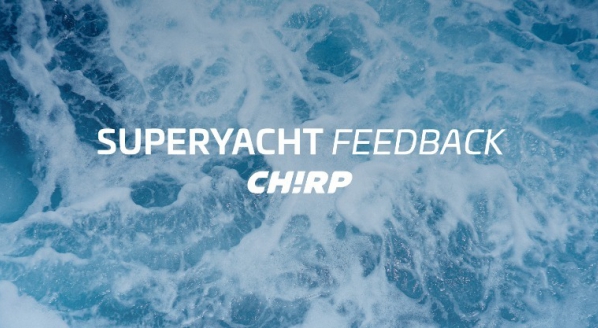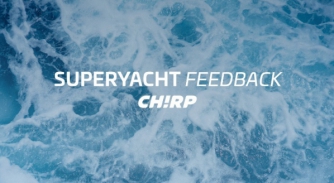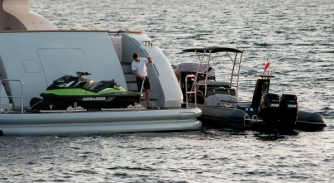A near miss
What procedures does your company have when a storm strikes while passengers and crew are engaged in recreational water sports? …

The following case study is from Superyacht Feedback, from CHIRP Maritime, the first superyacht-specific programme and publication dedicated to improving safety in the maritime industry through vital knowledge sharing, anonymous reporting, analysis and feedback via the Superyacht Maritime Advisory Board.
Initial Report
In this incident, a large yacht was anchored in a confined area with other yachts when a sudden squall with strong winds struck. The anchor chain stretched, and the yacht began to drag the anchor, which was confirmed by the radar anchor watch. To respond, the bridge team started the main engines to reposition the yacht.
However, the crew in the water, who were busy securing recreational water equipment like jet skis, must be made aware that the engine was about to start. When the swim platform was raised for manoeuvring, those in the water could not reboard the yacht.
With no means of communication and the strong wind making it difficult to shout warnings, the crew dropped a line into the water to allow the yacht to manoeuvre freely. Those in the water had no choice but to get on the jet skis to stay afloat and were forced to tow inflatables, lines and other skis away from the yacht, making the situation more complicated.
The propulsion system was engaged without warning, creating a severe safety risk. At this crucial moment, the captain and chief officer were on the bridge while the second officer was on a break. There were no officers available on deck to manage the unfolding situation.
CHIRP Comment
This incident highlights the critical importance of effective communication, adherence to safety procedures and situational awareness to prevent potentially hazardous scenarios involving crew members and watercraft near the yacht.
Line squalls, a common meteorological phenomenon, can be predicted with a vigilant bridge watch during recreational activities, including a weather forecast in the assessment before deploying watercraft equipment, which is fundamental. Once the decision to deploy watercraft and allow passengers and crew into the water is made, the bridge must always be aware of who and what equipment is in the water, and continuous monitoring is imperative. Unfortunately, in this case, the lack of rapid communication between the bridge team and the crew in the water compromised safety.
The morning toolbox talk should encompass all planned recreational activities, emphasising communication protocols, weather forecasts, and contingency plans for aborting activities if conditions become unsafe.
A thorough review of the anchor-dragging procedure is necessary for a dragging anchor. Initiating engine operations without informing anyone, especially with passengers and crew in the water without communication, poses a significant danger. Before any yacht manoeuvres, it is crucial to ensure the proper securing or retrieval of water sports equipment to prevent damage to propellers and the motoryacht.
Effective safety management involves assigning designated crew members the responsibility for deck safety, ensuring a constant focus on safety, even without officers present. Monitoring weather conditions, particularly preparedness for sudden changes like a line squall, is essential for proactive safety measures.
Regular safety training for all crew members is required, including routine safety drills to prepare the crew for emergencies, such as “cutaway procedures.”
Following an incident, conducting a thorough review is imperative. This post-incident analysis is crucial for learning from the experience and implementing improvements in safety measures on the yacht to prevent similar incidents in the future.
Key Issues
Situational Awareness: The imminent change in weather was realised when it was too late and prevented early action to get everyone back on board safely. What procedures does your company have for deteriorating weather when passengers and crew are engaged in recreational water sports? Do you carry out a “cutaway” drill?
Capability: can your officers recognise the signs of a line squall?
Distractions: With passengers and guests in the water, this should be classified as high-risk. Focusing on the vessel and passengers must be the top priority, with nothing to create a distraction.
Communications: Do you announce to all passengers and crew that this activity will be cut short if the weather conditions change? How do you inform your passengers and crew in similar circumstances?
Alerting: How would you arrange to alert everyone in the water engaged in water sports? What communications equipment does your vessel possess?
CHIRP Maritime, a UK-registered charity, has launched Superyacht Feedback, the first superyacht-specific programme and publication to improve safety in the maritime industry through confidential reporting and safety analysis on board. To register, or submit your feedback, please click here.
Profile links
NEW: Sign up for SuperyachtNewsweek!
Get the latest weekly news, in-depth reports, intelligence, and strategic insights, delivered directly from The Superyacht Group's editors and market analysts.
Stay at the forefront of the superyacht industry with SuperyachtNewsweek
Click here to become part of The Superyacht Group community, and join us in our mission to make this industry accessible to all, and prosperous for the long-term. We are offering access to the superyacht industry’s most comprehensive and longstanding archive of business-critical information, as well as a comprehensive, real-time superyacht fleet database, for just £10 per month, because we are One Industry with One Mission. Sign up here.
Related news

CHIRP Report: Tender grounded in darkness
What equipment do you have to direct your tender? This crew entered an unfamiliar hazardous area by veering off the course used during daylight hours
Crew

CHIRP Report: Lift E-Foil Battery Thermal Run-away
Would your crew notify the master if a battery was dropped? This time, an excellent, coordinated response extinguished a fire threat
Crew

Virsec launches lithium-ion safety course
In the wake of increasing fire rates derived from batteries, the eLearning security training specialists have curated a safety programme for crew
Crew
.jpg)
UKSA launches engineering crew training course
Training course introduced to help address skills gap
Crew

Talking about our next generation
The problems of procuring and retaining new talent in the industry were painfully evident during Lürssen's TSF: Connect session
Crew
Related news
CHIRP Report: Tender grounded in darkness
2 years ago
Virsec launches lithium-ion safety course
2 years ago
UKSA launches engineering crew training course
2 years ago
Talking about our next generation
2 years ago
NEW: Sign up for
SuperyachtNewsweek!
Get the latest weekly news, in-depth reports, intelligence, and strategic insights, delivered directly from The Superyacht Group's editors and market analysts.
Stay at the forefront of the superyacht industry with SuperyachtNewsweek



